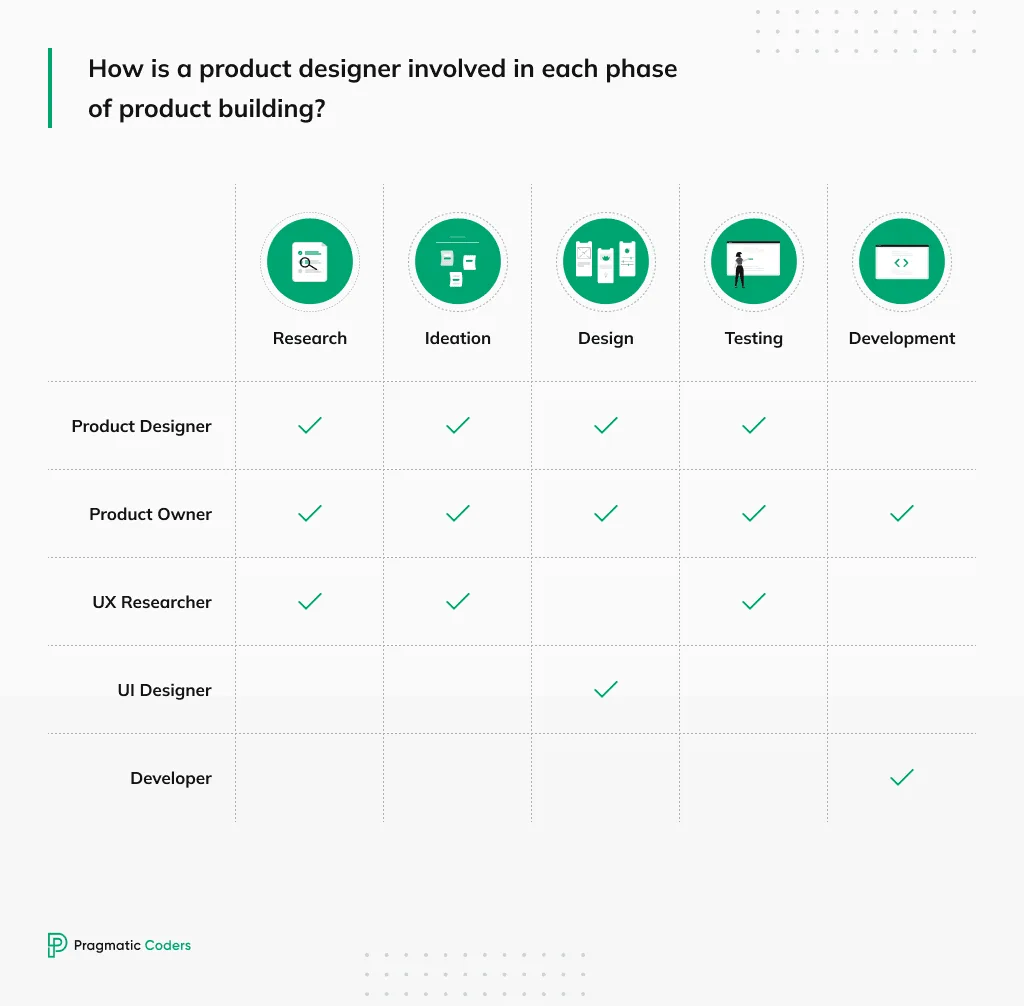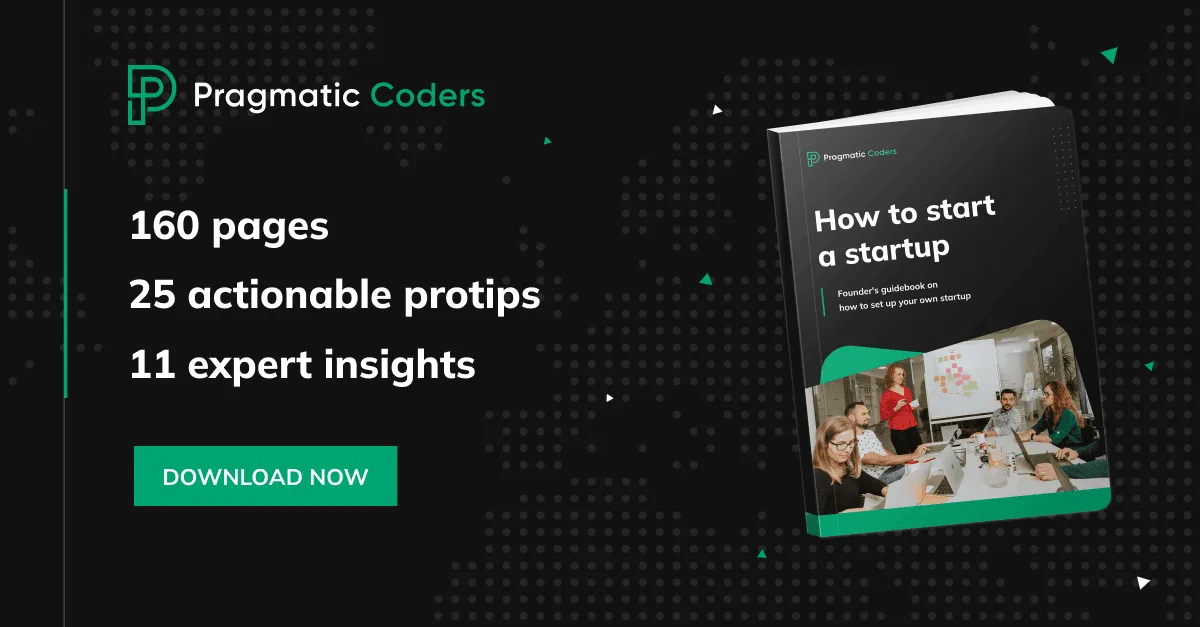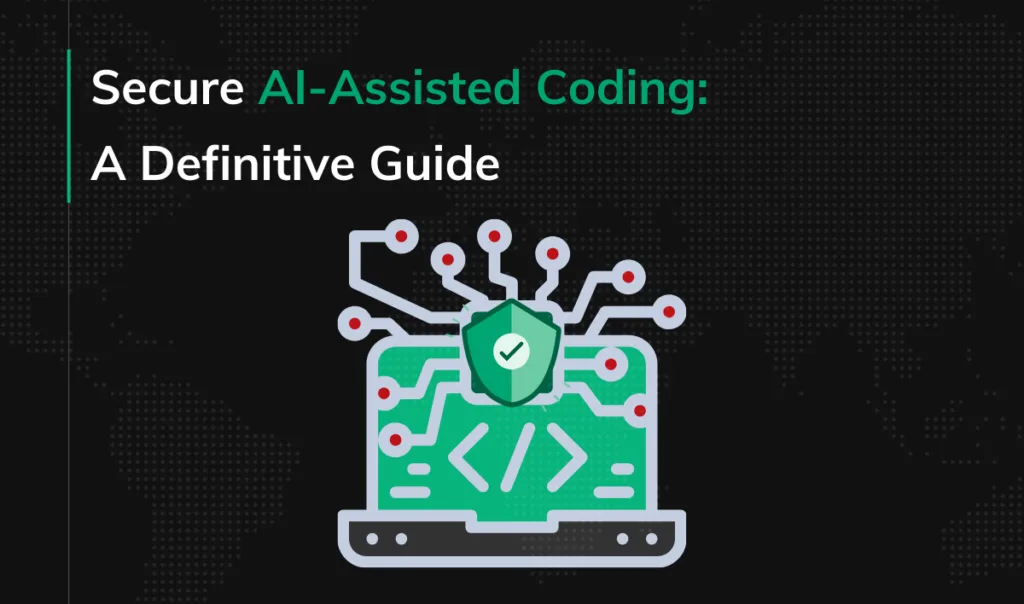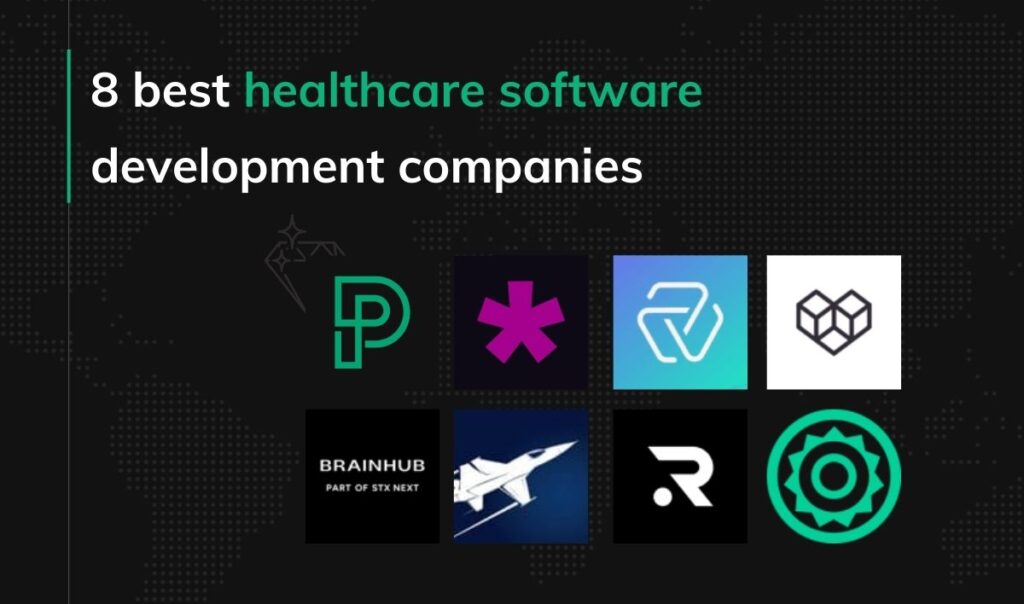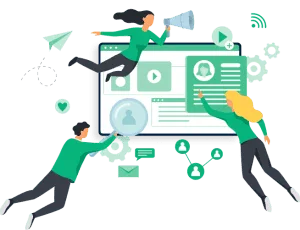What does a Product Designer do? Product Design vs. UX easily explained
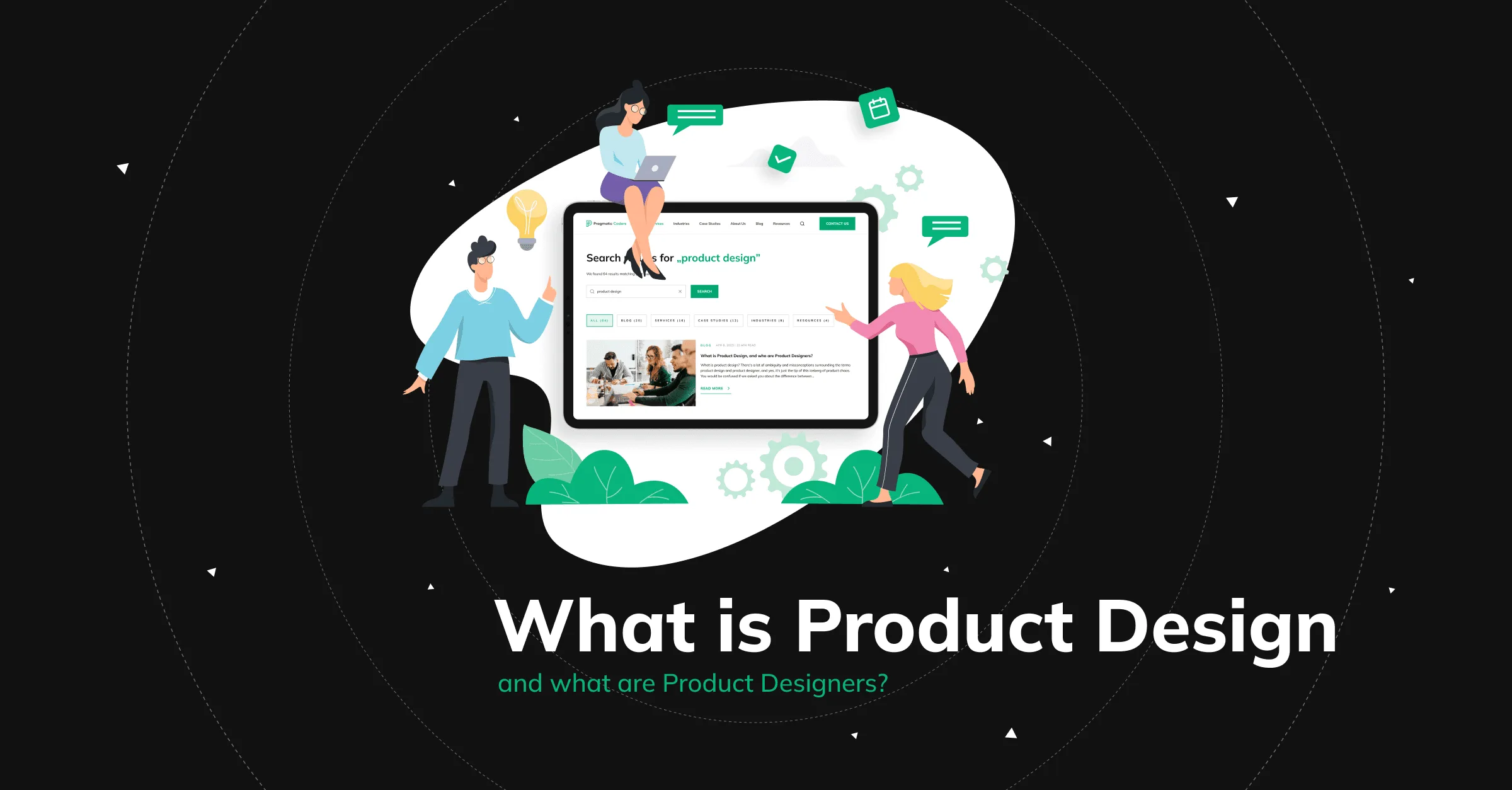
What is product design? There’s a lot of ambiguity and misconceptions surrounding the terms product design and product designer, and yes, it’s just the tip of this iceberg of product chaos.
You would be confused if we asked you about the difference between a product designer and a UX designer, and we haven’t even started inquiring you about what user interface designers and product managers (or product owners) have to do with it…
But don’t worry – we’ll resolve all your doubts in this article.
The basics of Product Design
Let’s start by briefly defining the basics of our topic.
What is a product?
In the broadest understanding, a product is a tangible or intangible item made or created through researching, designing, and developing to satisfy a customer’s needs or desires. In our case, we’ll only talk about digital products, mainly: mobile and web applications.
We’re drawing your attention to this because product design can also apply to physical products and is often confused with industrial design. However, that doesn’t apply to our case.
What is design?
Design is creating something with a specific purpose, incorporating functionality, usability, and aesthetics considerations.
What is Product Design (in terms of digital products)?
Product design is the process of creating a product to meet the needs and desires of the target market. The product should be functional, user-friendly, aesthetically pleasing, and commercially viable.
Product design aims to create products that solve real problems, improve people’s lives, and create value for the business.
What is a Product Designer?
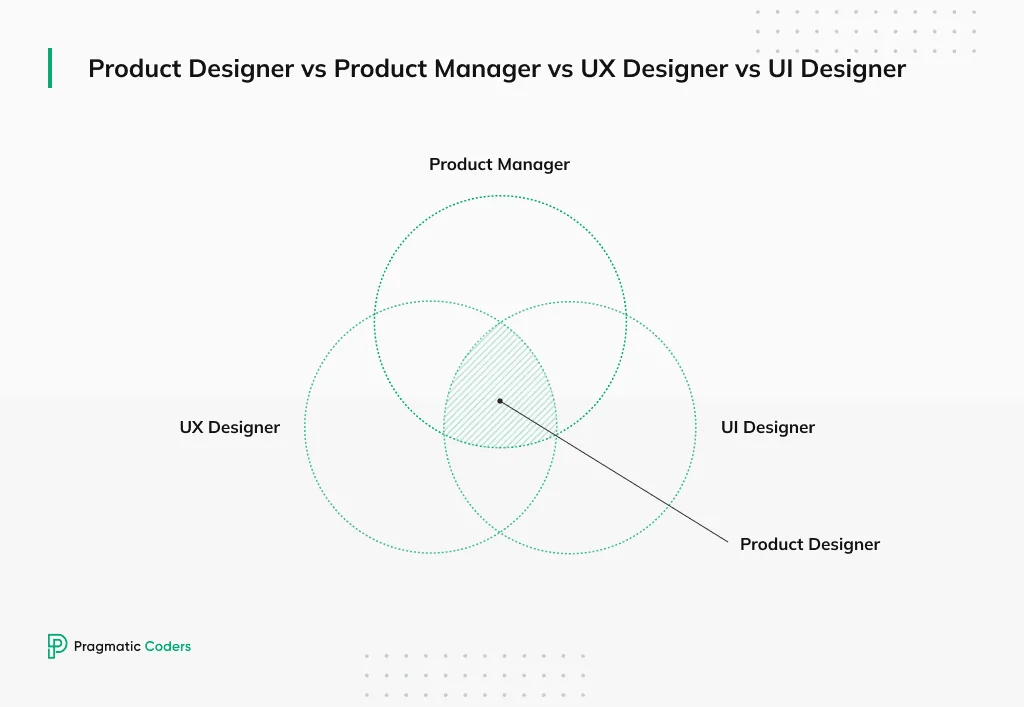
In the previous paragraph, we bolded the critical aims of product design not without reason. They show how the role of a product designer is a mixture of competencies of other jobs, as shown in the graph above.
So, a product designer wears many hats, and is somewhat of a product manager, a UI designer, and quite a lot of a UX researcher. Product designers concentrate on creating products that are aesthetically pleasing (UI), functional (UX), and tailored to user needs (researcher) but also profitable & centered around business objectives (Product Manager).
Product design vs. user interface design
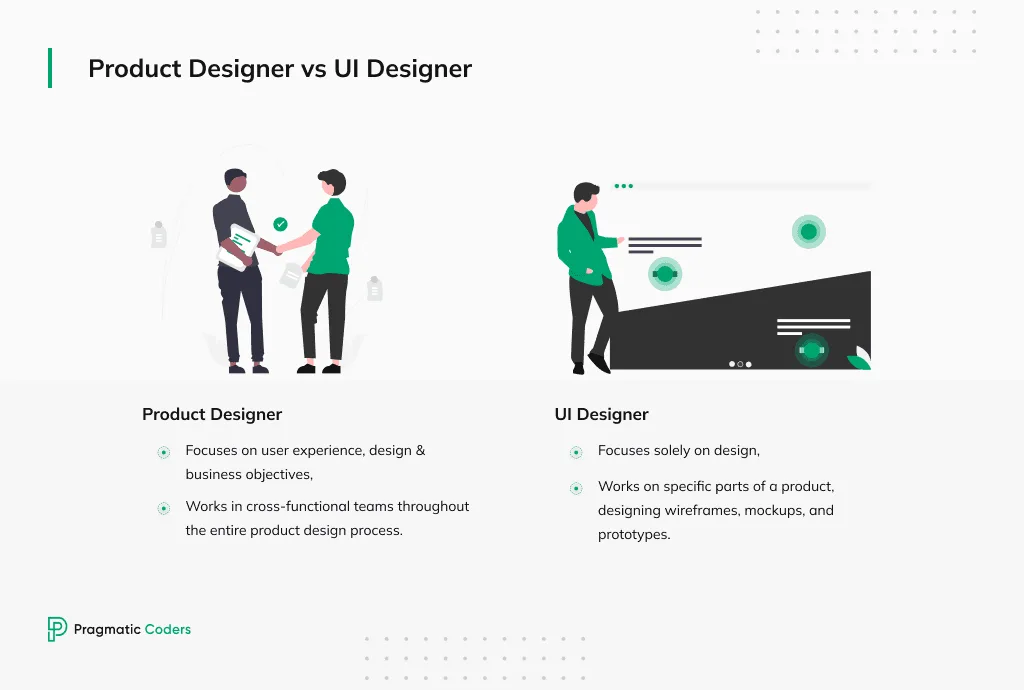
We’ll start by differentiating product designers from UI designers, as the discrepancies in job responsibilities are the biggest here.
Product designers have a broader scope and focus on the overall product experience and business outcomes. In contrast, UI designers specialize just in the visual design of the user interface.
Product designers are involved in the entire product development process, from ideation to launch and beyond. UI designers typically work on the interfaces and focus on the visual components of the product.
If you wish to learn more about visual design, check this piece of writing 
Product design vs. UX design
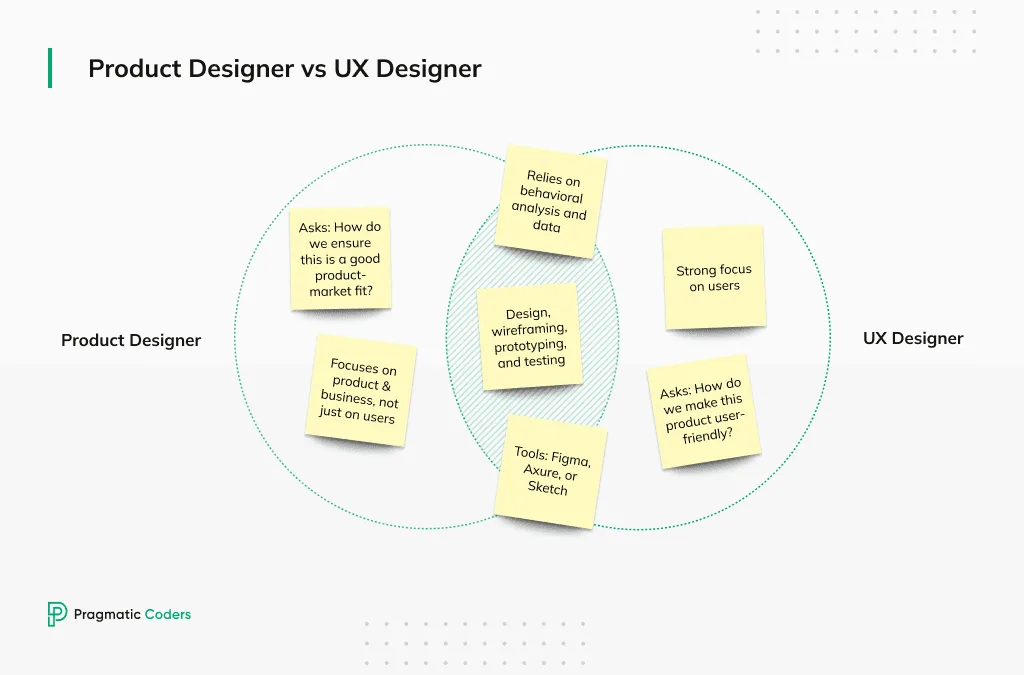
Product designers’ and UX designers’ job duties overlap; that’s why UX designers often convert to Product Designers and the other way around.
Before we go to the differences, let’s start with the similarities between these two roles.
- Both roles require a similar approach to design thinking, which involves creating new products and services based on a deep understanding of user needs and problems.
- They both focus on creating better products for users.
- They rely on behavioral analysis and data to inform their work.
- Competencies in interaction design, wireframing, prototyping, and research are essential for both positions.
- The tools used in these positions are similar, with the most commonly used visual design tools such as Figma, Axure, or Sketch.
And now for the differences:
- A Product Designer must have a broader view of creating solutions that include the business perspective, which is unnecessary for a user experience designer. A Product Designer is also responsible for the entire brand or product, as they are accountable for its concept, creation, development, and market position. A UX Designer has a narrower focus and is concentrated on designing user experiences.
- A UX Designer is more focused on solving the current problem of the user. At the same time, a Product Designer is focused on thinking of the product prospectively.
- While a UX Designer might ask, “How do we make this product user-friendly?” a Product Designer will wonder, “How do we make this product profitable?“
- Product Designer helps to create product designs and works on product goals and roadmaps. A UX Designer creates a product’s operational concept (mockups, processes, solutions).
Here’s more about how correctly conducted UX research looks like:

Product design vs. product management
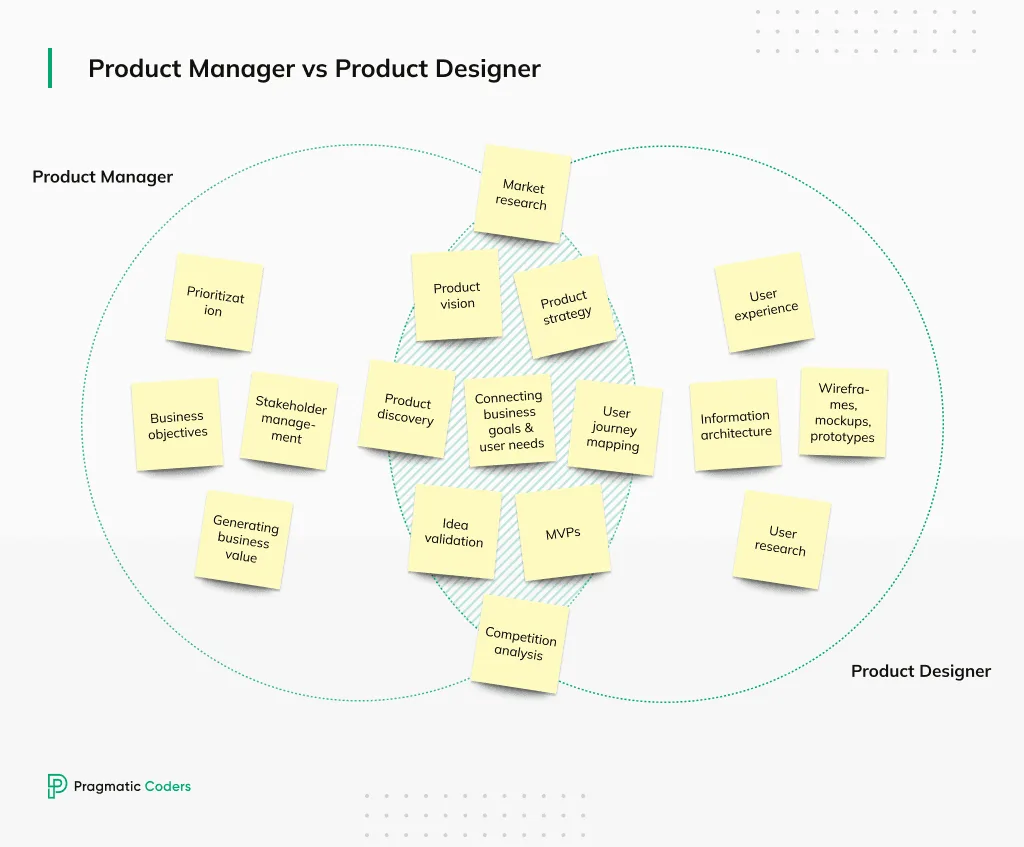
Disclaimer: There’s a never-ending discussion about the relationship between the terms Product Manager and Product Owner; some people see these roles as two separate jobs, and others use the words alternately. In our understanding, a Product Owner is a Product Manager that works specifically in the Scrum framework. As in this article, we won’t focus on the Agile-Scrum methodology, so we’ll stick to Product Managers. However, remember that what I say about them equally applies to Product Owners.
Both product designers and product managers operate in the fields of business and marketing.
However, product managers have a much deeper understanding of entrepreneurship. Moreover, they, not anyone else, organize the development process by prioritizing and assigning the right tasks to developers. Product designers connect user needs and business goals; product managers concentrate on the second.
But what actually is a Product Manager (Owner)? Read this 
Product design process – what does it look like?
We’ve finally explained all this tangled-up terminology; we can now move on to the clue of this article, that is, the product design process itself.
In the graphic above, you can see what the process looks like, what roles are involved in the entire design process, and at what stages.
It’s important to note that this IS NOT a linear process, though, so treat this scheme as a simplification rather than an accurate reflection of reality.
Below, you’ll find out
- What each stage is all about, and what activities it involves;
- What the role of the Product designer is at each stage.
A Product Designer may take care of all, most, or just some of the responsibilities mentioned below.

Research
The product design process starts by gathering information about the problem the product is intended to solve, the users who will use the product, and the market in which the product will exist. This can include user research, market research, and competitor analysis.
What does a product designer do here?
Primary responsibility: UX research
Optional responsibilities: market research, competitor analysis
Ideation
In this stage of the design process, designers generate ideas for the product based on the insights gained during the research stage. This can involve brainstorming, sketching, and creating rough paper prototypes.
The ideation often occurs during product discovery workshops, where a startup team gathers to work out creative solutions and develop an idea for a profitable startup product. This is typically done using techniques such as user journey mapping, brainstorming user stories and product functions, or designing user flows.
That’s also where the product vision and the first business goals are set, and it is defined how the product will function in terms of the market (in other words, how you will make money on it).
What does a Product Designer do here?
Primary responsibility: Creating inputs from user research into actionable deliverables (personas, user journey maps, empathy maps, ecosystem maps), developing product vision together with the product team, designing main product functionalities, and mapping out user flows.
Optional responsibilities: Mapping out user stories and preparing business artifacts (Value Proposition Canvas, Business Model Canvas, Lean Canvas)
Design
Here, designers refine the best ideas generated during the ideation stage, turn them into more detailed designs, and create wireframes, mockups, and high-fidelity prototypes.
Each stage of the design may require various levels of detail. It depends on the purpose of the design.
Do you want to test the product concept and check if users understand how to get around the app? Do you want to show it to investors, or is it needed for the development documentation?
The most complex projects will need their own design system (=building blocks [typography, colors, spacing, etc.] for consistent, efficient products) so the product will have a coherent look.
What does a Product Designer do here?
Primary responsibility:
- Designing wireframes,
- Creating low- and high-fidelity prototypes,
- Creating final interfaces, interactions, and information architecture,
- Creating style guides and design systems,
- UX writing.
Optional responsibilities: There are no optional responsibilities. This is the core of the work of the Product Designer
Testing/Validation
Once the designs are complete, they must be tested with users to ensure they meet their needs and are easy to use. This can involve usability testing, A/B testing, and other user feedback forms.
As mentioned above: you can test many things. It depends on what you want to learn. Product Designers can help you validate the value proposition you have for your users or test whether the design is user-friendly. What are the most burning issues you can address with your product? Are users willing to pay for your product? Is it a suitable market fit? A Product Designer will help you answer these questions.
What does a product designer do here?
Primary responsibility: Testing products, prototypes, and mockups with users, conducting interviews with potential customers, and collecting feedback from feedback forms.
Optional responsibilities: Creating new product ideas and updates based on data, insights, and user behavior patterns from analytic platforms (like Google Analytics or Yandex.Metrika).
Development
Finally, the designs are turned into a working product through development. This can involve coding, engineering, and other technical tasks to create a final product that meets the needs of the users and the business.
In this phase, Product Designer should focus on working with the development team so the design handout process goes smoothly. It is the time for designers and developers to work closely and iron out any discrepancies.
What does a product designer do here?
Primary responsibility: Quality checking, usability testing, and looking for new product opportunities.
Optional responsibilities: New function design.
Growth
Everything that happens now is basically developing your product, testing if the new functionalities work and make sense, acquiring users, growing the product again, testing it once more, and so on.
After the product is launched, the process has made a full circle, and it is wise to use Products Designer research skills to start looking for new growth opportunities for your product.
A potentially controversial question: can a Product Designer replace UX designers, Product Managers, or Visual Designers?
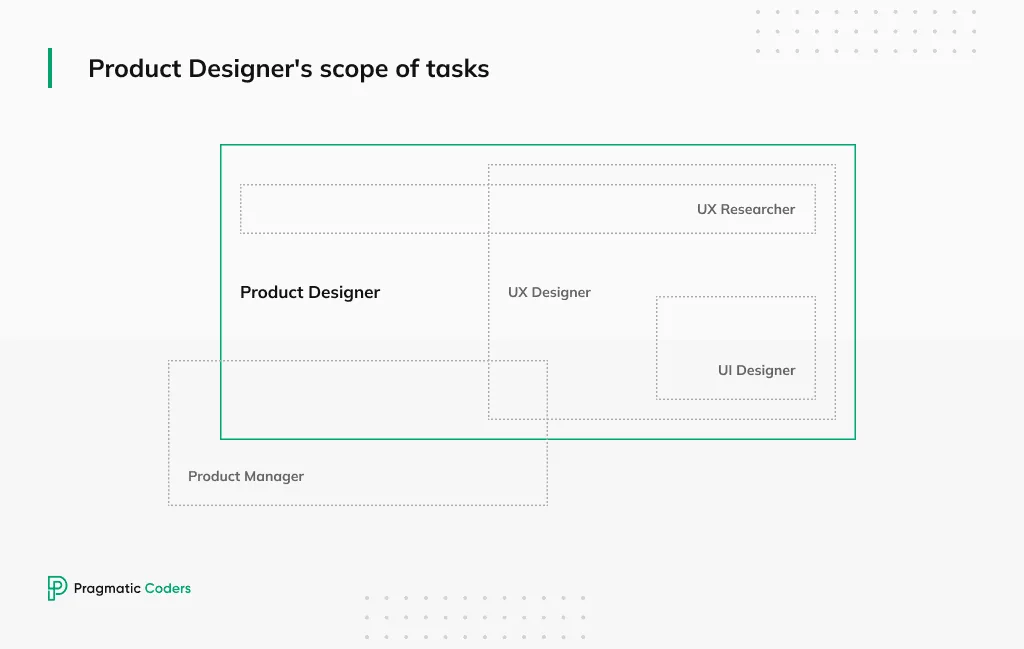
You’re a startup founder, so we’re sure there’s a question on your mind: “Does it make any sense to hire Product managers, UX designers, or UI designers if I can take on just one Product Designer instead?”.
It’s logical, right? A Product Designer doesn’t have precisely all the competencies of the abovementioned roles. Still, they could be enough for a young business, wouldn’t they?
To satisfy your curiosity, we asked Pragmatic Coders’ Product Designer, Aga Lesz, for her opinion; this is what she thinks
Specialized positions can usually be found in larger companies where they can focus on one area and dig deeper when working on a mature product.
In a startup, someone who has a broader set of skills, like a Product Designer, will be a good match – you need a person who can understand the business perspective but will bring their research and design expertise to the table. But don’t skip on a Product Owner (or Manager)!
In my experience, that tandem works well: the Product Owner can expand the business knowledge of the Product Designer and take ownership of that part. Product Designers can provide Product Owners with invaluable insights from the research and always have the user perspective in mind when developing solutions.
Conclusions
Here’s a super quick summary of what you’ve just learned about a Product Designer’s job:
- Product design is the process of creating digital products that are functional, user-friendly, aesthetically pleasing, and commercially viable.
- To become a Product Designer, you need a mixture of competencies of other jobs, such as Product Manager, UI designer, and UX researcher.
- Product Designers are present during the entire product creation process, with their main focus being the Design stage.
- Because of their broad set of skills, Product Designers are a great match for early-stage startups.
All your questions or doubts should be resolved at this point. However, if you have any additional questions regarding Product Design for your startup or any other area of our expertise, just email or call us!

